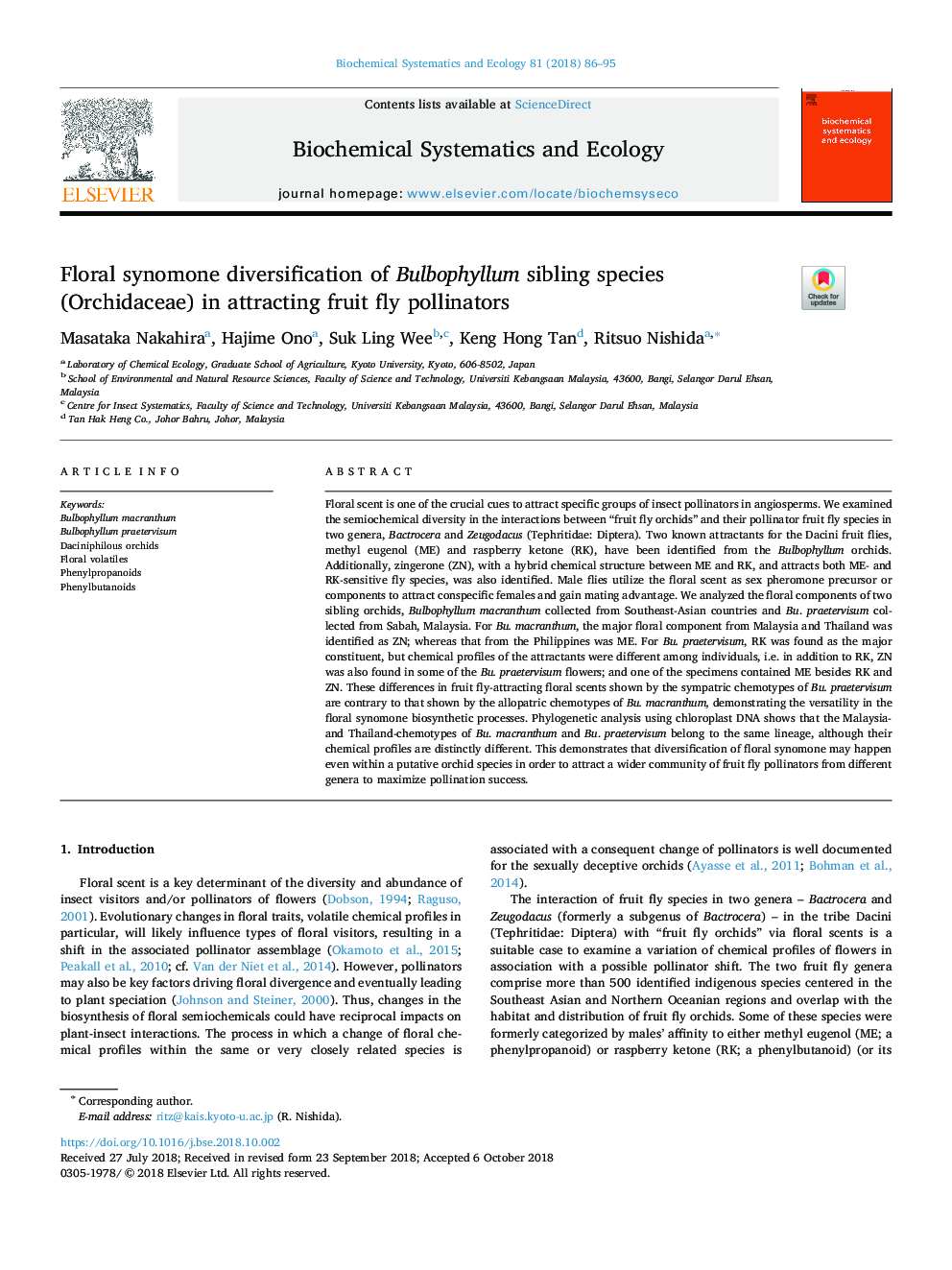| کد مقاله | کد نشریه | سال انتشار | مقاله انگلیسی | نسخه تمام متن |
|---|---|---|---|---|
| 11031219 | 1646058 | 2018 | 10 صفحه PDF | دانلود رایگان |
عنوان انگلیسی مقاله ISI
Floral synomone diversification of Bulbophyllum sibling species (Orchidaceae) in attracting fruit fly pollinators
دانلود مقاله + سفارش ترجمه
دانلود مقاله ISI انگلیسی
رایگان برای ایرانیان
موضوعات مرتبط
مهندسی و علوم پایه
شیمی
شیمی آلی
پیش نمایش صفحه اول مقاله

چکیده انگلیسی
Floral scent is one of the crucial cues to attract specific groups of insect pollinators in angiosperms. We examined the semiochemical diversity in the interactions between “fruit fly orchids” and their pollinator fruit fly species in two genera, Bactrocera and Zeugodacus (Tephritidae: Diptera). Two known attractants for the Dacini fruit flies, methyl eugenol (ME) and raspberry ketone (RK), have been identified from the Bulbophyllum orchids. Additionally, zingerone (ZN), with a hybrid chemical structure between ME and RK, and attracts both ME- and RK-sensitive fly species, was also identified. Male flies utilize the floral scent as sex pheromone precursor or components to attract conspecific females and gain mating advantage. We analyzed the floral components of two sibling orchids, Bulbophyllum macranthum collected from Southeast-Asian countries and Bu. praetervisum collected from Sabah, Malaysia. For Bu. macranthum, the major floral component from Malaysia and Thailand was identified as ZN; whereas that from the Philippines was ME. For Bu. praetervisum, RK was found as the major constituent, but chemical profiles of the attractants were different among individuals, i.e. in addition to RK, ZN was also found in some of the Bu. praetervisum flowers; and one of the specimens contained ME besides RK and ZN. These differences in fruit fly-attracting floral scents shown by the sympatric chemotypes of Bu. praetervisum are contrary to that shown by the allopatric chemotypes of Bu. macranthum, demonstrating the versatility in the floral synomone biosynthetic processes. Phylogenetic analysis using chloroplast DNA shows that the Malaysia- and Thailand-chemotypes of Bu. macranthum and Bu. praetervisum belong to the same lineage, although their chemical profiles are distinctly different. This demonstrates that diversification of floral synomone may happen even within a putative orchid species in order to attract a wider community of fruit fly pollinators from different genera to maximize pollination success.
ناشر
Database: Elsevier - ScienceDirect (ساینس دایرکت)
Journal: Biochemical Systematics and Ecology - Volume 81, December 2018, Pages 86-95
Journal: Biochemical Systematics and Ecology - Volume 81, December 2018, Pages 86-95
نویسندگان
Masataka Nakahira, Hajime Ono, Suk Ling Wee, Keng Hong Tan, Ritsuo Nishida,